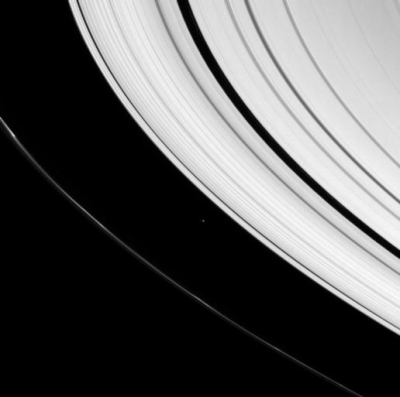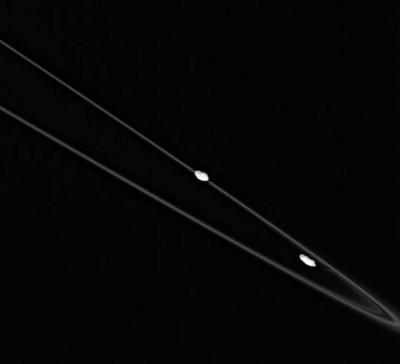12 June 2007

Credit: NASA/JPL/Space Science Institute
NASA recently published an exquisite image of Saturn's rings, acquired by the Saturn-bound Cassini spacecraft. The image shows Atlas, Saturn's tiny inner moon, gliding in the space between the A and F rings.
Atlas (32 km across) shines as a small dot, near the outer edge of the brighter A ring. Clumps of material in the F ring are also visible. (Saturn's rings have been named in order of their discovery.)
The A ring is one of the two largest Saturnian rings. The diameter of its outer edge is approximately 270,000 km. A gap, known as the Cassini Division, lies between the A ring and the B ring, Saturn's densest ring. This gap is approximately 5,000 km wide. It is not entirely empty, but it contains thin ringlets. There are also other gaps in the Saturnian rings, and they are due to the gravitational attraction of one or more of Saturn's moons, exerted on the tiny particles of the rings.
The F ring is one of Saturn's faint, outer rings. It is approximately 280,000 km in diameter and only a few hundred km wide. It was discovered in 1979. The small moons Prometheus (91 km across) and Pandora (84 km across) are the shepherd moons of the F ring. Prometheus is the inner of the two moons.

A Cassini spacecraft image of the F ring, Prometheus and Pandora
Credit: NASA/JPL/Space Science Institute
Cassini was looking on the dark side of the rings, from about 13° above the ringplane. The image was taken in visible light with Cassini's narrow-angle camera on 29 April 2007. The spacecraft was approximately 1.8 million km from Atlas. Image scale is 11 km per pixel.
Further Reading
A Dive in Saturn's Shadow
http://www.bibalex.org/eclipse2006/News_Details.aspx?id=202
Cassini-Huygens Mission
http://saturn.jpl.nasa.gov/home/index.cfm
Aymen Mohamed Ibrahem
Senior Astronomy Specialist